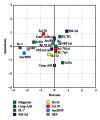Assessment of T regulatory cells and expanded profiling of autoantibodies may offer novel biomarkers for the clinical management of systemic sclerosis and undifferentiated connective tissue disease
- PMID: 23818915
- PMCID: PMC3681301
- DOI: 10.1155/2013/390563
Assessment of T regulatory cells and expanded profiling of autoantibodies may offer novel biomarkers for the clinical management of systemic sclerosis and undifferentiated connective tissue disease
Abstract
In order to identify disease biomarkers for the clinical and therapeutic management of autoimmune diseases such as systemic sclerosis (SSc) and undifferentiated connective tissue disease (UCTD), we have explored the setting of peripheral T regulatory (T reg) cells and assessed an expanded profile of autoantibodies in patients with SSc, including either limited (lcSSc) or diffuse (dcSSc) disease, and in patients presenting with clinical signs and symptoms of UCTD. A large panel of serum antibodies directed towards nuclear, nucleolar, and cytoplasmic antigens, including well-recognized molecules as well as less frequently tested antigens, was assessed in order to determine whether different antibody profiles might be associated with distinct clinical settings. Beside the well-recognized association between lcSSc and anti-centromeric or dcSSC and anti-topoisomerase-I antibodies, we found a significative association between dcSSc and anti-SRP or anti-PL-7/12 antibodies. In addition, two distinct groups emerged on the basis of anti-RNP or anti-PM-Scl 75/100 antibody production among UCTD patients. The levels of T reg cells were significantly lower in patients with SSc as compared to patients with UCTD or to healthy controls; in patients with lcSSc, T reg cells were inversely correlated to disease duration, suggesting that their levels may represent a marker of disease progression.
Figures



References
-
- Gabrielli A, Avvedimento EV, Krieg T. Mechanisms of disease: scleroderma. The New England Journal of Medicine. 2009;360(19):1989–2003. - PubMed
-
- Hachulla E, Launay D. Diagnosis and classification of systemic sclerosis. Clinical Reviews in Allergy and Immunology. 2011;40(2):78–83. - PubMed
-
- Carwile LeRoy E, Black C, Fleischmajer R, et al. Scleroderma (systemic sclerosis): classification, subsets and pathogenesis. Journal of Rheumatology. 1988;15(2):202–205. - PubMed
-
- Hamaguchi Y. Autoantibody profiles in systemic sclerosis: predictive value for clinical evaluation and prognosis. Journal of Dermatology. 2010;37(1):42–53. - PubMed
-
- Subcommittee for Scleroderma Criteria of the American Rheumatism Association Diagnostic and Therapeutic Criteria Committee. Preliminary criteria for the classification of systemic sclerosis (scleroderma) Arthritis & Rheumatism. 1980;23(5):581–590. - PubMed
MeSH terms
Substances
LinkOut - more resources
Full Text Sources
Other Literature Sources
Medical
Research Materials
Miscellaneous

